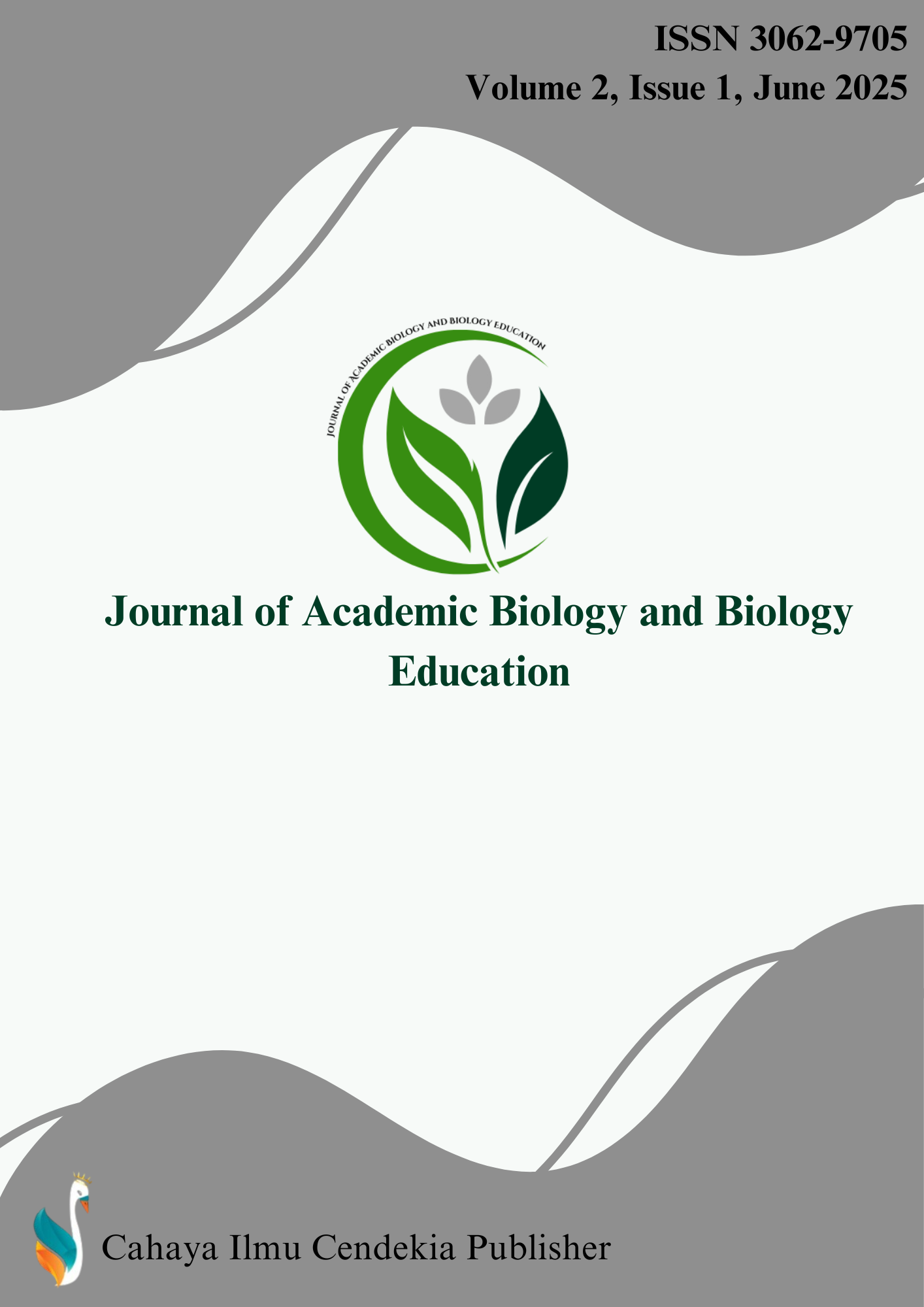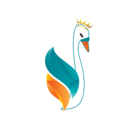SM2CL Model Innovation: Biology Learning Strategy to Sharpen Students' Critical Thinking
Abstract
Purpose of the study: This study aims to analyze the influence of the Synectics, Mind Maps, and Cooperative Learning (SM2CL) learning models on students' critical thinking skills in biology subjects.
Methodology: This study is a quasi-experimental study with a pretest-posttest control group design. The sampling technique used was total sampling with 47 students as samples. The research instruments consisted of essay tests and critical thinking scale questionnaires. Data were analyzed using descriptive and inferential statistics with normality tests, homogeneity tests, and t-tests using SPSS software version 24.
Main Findings: The Synectics, Mind Maps, and Cooperative Learning (SM2CL) learning model significantly improves students' critical thinking skills. The t-test results showed a significant difference between the experimental class and the control class, with a higher increase in post-test scores in the experimental class. The analysis data showed that the SM2CL model was effective in improving students' conceptual understanding and critical thinking skills in Biology subjects.
Novelty/Originality of this study: This study combines three learning models Synectics, Mind Maps, and Cooperative Learning (SM2CL), as an innovative approach to improve students' critical thinking in Biology. This study expands the understanding of the effectiveness of collaborative and visual methods in learning, and provides new insights into the application of integrated learning strategies in improving the quality of education.
References
A. Ashida, The Role of Higher Education in Achieving the Sustainable Development Goals, vol. Part F2748. Springer Nature Singapore, 2023. doi: 10.1007/978-981-19-4859-6_5.
S. Supa’at and I. Ihsan, “The challenges of elementary education in society 5.0 era,” Int. J. Soc. Learn., vol. 3, no. 3, pp. 341–360, 2023, doi: 10.47134/ijsl.v3i3.214.
I. Nikitina and T. Ishchenko, “Globalization of education: modern experience,” Sci. J. Pol. Univ., vol. 56, no. 1, pp. 216–223, 2023, doi: 10.23856/5630.
K. Shimizu, “The ASEAN Economic Community and the RCEP in the world economy,” J. Contemp. East Asia Stud., vol. 10, no. 1, pp. 1–23, 2021, doi: 10.1080/24761028.2021.1907881.
M. K. Budiarto, A. Rahman, Asrowi, Gunarhadi, and A. Efendi, “Proposing Information and Communication Technology (ICT)-based learning transformation to create competitive human resources: a theoretical review,” Multidiscip. Rev., vol. 7, no. 4, 2024, doi: 10.31893/multirev.2024076.
S. M. Indrawati and A. and Kuncoro, “Improving Competitiveness Through Vocational and Higher Education: Indonesia’s Vision For Human Capital Development In 2019–2024,” Bull. Indones. Econ. Stud., vol. 57, no. 1, pp. 29–59, Jan. 2021, doi: 10.1080/00074918.2021.1909692.
O. Nagy, I. Papp, and R. Z. Szabó, “Construction 4.0 organisational level challenges and solutions,” Sustain., vol. 13, no. 21, pp. 1–18, 2021, doi: 10.3390/su132112321.
A. S. Taflı and S. Bayram, “Impacts of syrian construction workers on the Turkish AEC industry,” Erciyes Üniversitesi Fen Bilim. Enstitüsü Fen Bilim. Derg., vol. 37, no. 3, pp. 441–451, 2021.
S. F. Rivas, C. Saiz, and L. S. Almeida, “The Role of Critical Thinking in Predicting and Improving Academic Performance,” Sustain., vol. 15, no. 2, pp. 1–10, 2023, doi: 10.3390/su15021527.
H. Yu, “Reflection on whether Chat GPT should be banned by academia from the perspective of education and teaching,” Front. Psychol., vol. 14, 2023, doi: 10.3389/fpsyg.2023.1181712.
H. Lijie, S. Mat Yusoff, and A. F. Mohamad Marzaini, “Influence of AI-driven educational tools on critical thinking dispositions among university students in Malaysia: a study of key factors and correlations,” Educ. Inf. Technol., vol. 30, no. 6, pp. 8029–8053, 2025, doi: 10.1007/s10639-024-13150-8.
M. Alenezi, S. Wardat, and M. Akour, “The Need of Integrating Digital Education in Higher Education: Challenges and Opportunities,” Sustain., vol. 15, no. 6, pp. 1–12, 2023, doi: 10.3390/su15064782.
Y. A. Alkhabra, U. M. Ibrahem, and S. A. Alkhabra, “Augmented reality technology in enhancing learning retention and critical thinking according to STEAM program,” Humanit. Soc. Sci. Commun., vol. 10, no. 1, pp. 1–10, 2023, doi: 10.1057/s41599-023-01650-w.
X. Huang and C. Qiao, “Enhancing computational thinking skills through artificial intelligence education at a STEAM high school,” Sci. Educ., vol. 33, no. 2, pp. 383–403, 2024, doi: 10.1007/s11191-022-00392-6.
H. Geng, “Redefining the role of teachers in developing critical thinking within the digital era,” Proc. 2021 Int. Conf. Mod. Educ. Technol. Soc. Sci. (ICMETSS 2021), vol. 573, no. Icmetss, pp. 18–21, 2021, doi: 10.2991/assehr.k.210824.005.
A. A. Razak et al., “Improving critical thinking skills in teaching through problem-based learning for students: A scoping review,” Int. J. Learn. Teach. Educ. Res., vol. 21, no. 2, pp. 342–362, 2022.
V. Bhardwaj, S. Zhang, Y. Q. Tan, and V. Pandey, “Redefining learning: student-centered strategies for academic and personal growth,” Front. Educ., vol. 10, no. February, pp. 1–15, 2025, doi: 10.3389/feduc.2025.1518602.
A. Carvalho, S. J. Teixeira, L. Olim, S. de Campanella, and T. Costa, “Pedagogical innovation in higher education and active learning methodologies – a case study,” Educ. Train., vol. 63, no. 2, pp. 195–213, 2021, doi: 10.1108/ET-05-2020-0141.
L. L. Hadar and D. L. and Brody, “Interrogating the role of facilitators in promoting learning in teacher educators’ professional communities,” Prof. Dev. Educ., vol. 47, no. 4, pp. 599–612, Aug. 2021, doi: 10.1080/19415257.2020.1839782.
J. R. Kroll, Preparing Leadership Educators. New York: Routledge, 2023. doi: 10.4324/9781003446446.
B. Daelmans, S. A. Manji, and N. Raina, “Nurturing care for early childhood development: global perspective and guidance,” Indian Pediatr., vol. 58, no. 1, pp. 11–15, 2021, doi: 10.1007/s13312-021-2349-5.
G. Islamic, Supriyono, M. Ishaq, and U. Dayati, “Character education through philosophical values in traditional Islamic boarding schools,” Kasetsart J. Soc. Sci., vol. 45, no. 1, pp. 31–42, 2023, doi: 10.34044/j.kjss.2024.45.1.04.
E. & M. M. Masnawati, “Family support and early childhood education: a qualitative perspective,” Int. J. Serv. Sci. Manag. Eng. Technol., vol. 3, no. 2, pp. 32–37, 2023, [Online]. Available: https://ejournalisse.com/index.php/isse/article/view/90/81
S. Li, Y. Tang, and Y. Zheng, “How the home learning environment contributes to children’s social–emotional competence: A moderated mediation model,” Front. Psychol., vol. 14, no. February, pp. 1–19, 2023, doi: 10.3389/fpsyg.2023.1065978.
C. Hart, C. Da Costa, D. D’Souza, A. Kimpton, and J. Ljbusic, “Exploring higher education students’ critical thinking skills through content analysis,” Think. Ski. Creat., vol. 41, p. 100877, 2021, doi: 10.1016/j.tsc.2021.100877.
S. F. Rivas, C. Saiz, and C. Ossa, “Metacognitive strategies and development of critical thinking in higher education,” Front. Psychol., vol. 13, no. June, 2022, doi: 10.3389/fpsyg.2022.913219.
D. Caled and M. J. Silva, Digital media and misinformation: An outlook on multidisciplinary strategies against manipulation, vol. 5, no. 1. Springer Singapore, 2022. doi: 10.1007/s42001-021-00118-8.
M. Shahbazi and D. Bunker, “Social media trust: fighting misinformation in the time of crisis,” Int. J. Inf. Manage., vol. 77, p. 102780, 2024, doi: 10.1016/j.ijinfomgt.2024.102780.
M. A. Almulla and W. M. Al-Rahmi, “Integrated social cognitive theory with learning input factors: the effects of problem-solving skills and critical thinking skills on learning performance sustainability,” Sustain., vol. 15, no. 5, 2023, doi: 10.3390/su15053978.
M. A. Almulla, “Constructivism learning theory: a paradigm for students’ critical thinking, creativity, and problem solving to affect academic performance in higher education,” Cogent Educ., vol. 10, no. 1, 2023, doi: 10.1080/2331186X.2023.2172929.
L. García-Pérez, M. García-Garnica, and E. M. Olmedo-Moreno, “Skills for a working future: how to bring about professional success from the educational setting,” Educ. Sci., vol. 11, no. 1, pp. 1–25, 2021, doi: 10.3390/educsci11010027.
A. Dilekçi and H. Karatay, “The effects of the 21st century skills curriculum on the development of students’ creative thinking skills,” Think. Ski. Creat., vol. 47, p. 101229, 2023, doi: 10.1016/j.tsc.2022.101229.
A. Marougkas, C. Troussas, A. Krouska, and C. Sgouropoulou, “Virtual reality in education: a review of learning theories, approaches and methodologies for the last decade,” Electron., vol. 12, no. 13, 2023, doi: 10.3390/electronics12132832.
K. J. Strom and K. M. Viesca, Towards a complex framework of teacher learning-practice, vol. 47, no. 2–3. 2021. doi: 10.1080/19415257.2020.1827449.
Riskawati, M. K. Mustami, and A. Afif, “The influence of the synectics mind maps cooperative learning ( SM2CL ) model on the students learning outcomes of class XI MAN Gowa,” J. Islam Sci., vol. 10, no. 1, pp. 44–48, 2023, doi: 10.24252/jis.v10i1.34094.
M. S. Taufik, M. K. Mustami, and E. Damayanti, “Pengaruh model pembelajaran Synectics, Mind Maps, Cooperative Learning (SM2CL) terhadap kemampuan berpikir kritis siswa [The influence of the Synectics, Mind Maps, Cooperative Learning (SM2CL) learning model on students’ critical thinking skills],” J. Biotek, vol. 6, no. 2, p. 61, 2018, doi: 10.24252/jb.v6i2.5378.
P. Damayanti, A. F. Hindriana, and Z. Abidin, “Penerapan model pembelajaran SM2CL untuk meningkatkan keterampilan berpikir kritis dan motivasi belajar siswa [Implementation of the SM2CL learning model to improve students’ critical thinking skills and learning motivation],” Quagga J. Pendidik. dan Biol., vol. 14, no. 1, pp. 9–15, 2022, doi: 10.25134/quagga.v14i1.4821.
A. Tongal, F. S. Yıldırım, Y. Özkara, S. Say, and Ş. Erdoğan, “Examining teachers’ computational thinking skills, collaborative learning, and creativity within the framework of sustainable education,” Sustain., vol. 16, no. 22, 2024, doi: 10.3390/su16229839.
J. Zhang, Y. Zhou, B. Jing, Z. Pi, and H. Ma, “Metacognition and mathematical modeling skills: the mediating roles of computational thinking in high school students,” J. Intell., vol. 12, no. 6, 2024, doi: 10.3390/jintelligence12060055.
B. Retni S, K. Dwi Agus, T. Elza, and P. Rahmat, “Evaluation of the results of attitudes and self-efficacy of middle school students in science subjects,” J. Educ. Res. Eval., vol. 5, no. 4, p. 525, 2021, doi: 10.23887/jere.v5i4.36409.
F. Orcan, “Parametric or non-parametric: skewness to test normality for mean comparison,” Int. J. Assess. Tools Educ., vol. 7, no. 2, pp. 255–265, 2020, doi: 10.21449/ijate.656077.
A. Amin, A. Alimni, D. A. Kurniawan, E. Triani, and W. A. Pratama, “Implications of teacher interpersonal communication ability on student learning motivation in islamic religious education lessons during pandemic,” J. Educ. Res. Eval., vol. 6, no. 1, pp. 156–167, 2022, doi: 10.23887/jere.v6i1.39547.
M. M. Baharom, N. A. Atan, M. S. Rosli, S. Yusof, and M. Z. A. Hamid, “Integration of science learning apps based on Inquiry Based Science Education (IBSE) in enhancing students Science Process Skills (SPS),” Int. J. Interact. Mob. Technol., vol. 14, no. 9, pp. 95–109, 2020, doi: 10.3991/ijim.v14i09.11706.
T. K. Kim, “T test as a parametric statistic,” Recipes Sci., vol. 68, no. 6, pp. 540–546, 2015, doi: 10.4097/kjae.2015.68.6.540.
C. S. De Brito, D. E. W. Silva, L. G. de A. Aguiar, R. Abrãao, and N. A. de S. Sampaio, “Using the paired T-Test to compare suppliers,” Rev. Gestão e Secr. (Management Adm. Prof. Rev., vol. 14, no. 10, pp. 18565–18575, 2023, doi: 10.7769/gesec.v14i10.3068.
M. N. Ismail, N. A. Ngah, and I. N. Umar, “The effects of mind mapping with cooperative learning on programming performance, problem solving skill and metacognitive knowledge among computer science students,” J. Educ. Comput. Res., vol. 42, no. 1, pp. 35–61, Jan. 2010, doi: 10.2190/EC.42.1.b.
Y. Herlanti, Y. Mardiati, R. Wahyuningtyas, E. Mahardini, M. Iqbal, and A. Sofyan, “Discovering learning strategy to increase metacognitive knowledge on biology learning in secondary school,” J. Pendidik. IPA Indones., vol. 6, no. 1, pp. 179–186, 2017, doi: 10.15294/jpii.v6i1.9605.
Copyright (c) 2025 Muhammad Sultani Taufik, Joan S. Awingan , Feona S. Carollo

This work is licensed under a Creative Commons Attribution 4.0 International License.
Authors who publish with this journal agree to the following terms:
- Authors retain copyright and acknowledge that the Journal of Academic Biology and Biology Education is the first publisher licensed under a Creative Commons Attribution 4.0 International License.
- Authors are able to enter into separate, additional contractual arrangements for the non-exclusive distribution of the journal's published version of the work (e.g., post it to an institutional repository or publish it in a book), with an acknowledgment of its initial publication in this journal.
- Authors are permitted and encouraged to post their work online (e.g., in institutional repositories or on their website) prior to and during the submission process, as it can lead to productive exchanges and earlier and greater citation of published work.



.png)

.png)
.png)








